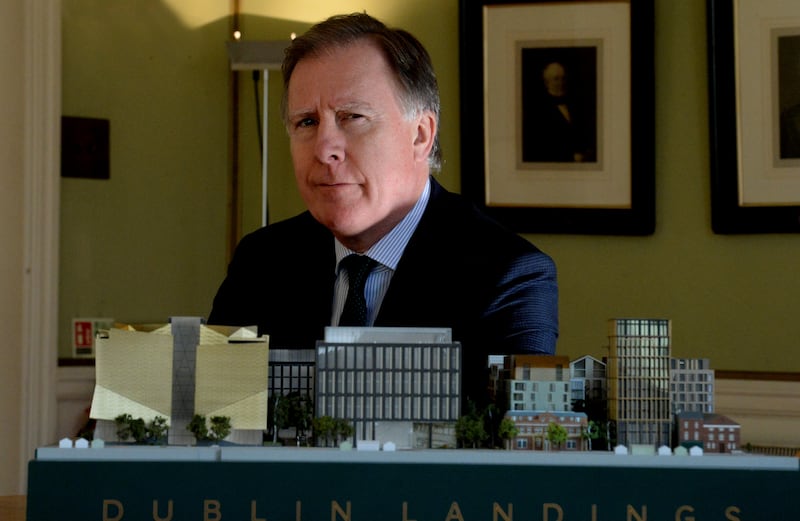Brian Hughes, a consultant demographer, was a teenager in 1961 when Ireland’s population hit rock bottom after more than a century of decline since the Famine. The population in the “nadir census” that year was only 2.82 million, a dire indication of failing, insular economics and rampant emigration. Blinkered self-sufficiency had led only to an impoverished State.
This is the prism through which Hughes starts to analyse recent census data that puts the State’s population at a record 5.12 million, easily the highest since mass starvation in the mid-1800s and a count that rose some 361,000 in the six years from 2016.
It is an altered demographic landscape, the figures reflecting extraordinary growth in Dublin and its hinterland in the decades since Hughes took Inter Cert exams 61 years ago. He went to qualify as a chartered surveyor and work as a lecturer at UCD and TU Dublin and in property investment and management with Irish Life, interested always in the forces driving demand for residential and commercial real estate
“Dublin and environs is 1.25 million in population, now more than one million greater than Cork and environs,” says Hughes, a member for 15 years of the Central Statistics Office (CSO) expert group on population and labour force projection.
READ MORE
“There are 40,000 more people now living in Leinster in 2022 than in the entire of the Republic in 1961 – 40,000 is a good crowd in Lansdowne Road for a soccer match, or nearly a good crowd for a rugby match.”
Because of Leinster’s advance, Hughes believes some of the strongest population growth in coming decades will be in the “corridor” between Dublin and Belfast. That, in turn, increases the prospect of a new city emerging over time from the expansion of Drogheda and surrounding areas.
“The preliminary [census data] confirms the near 13 per cent increase in the core seven electoral districts that comprise Drogheda and Laytown-Bettystown-Mornington since 2016,” he says.
“Their ongoing physical fusion and agglomeration is resulting in the emergence of the State’s sixth city – it could even be the fifth one depending on how this compares with the 2022 population of Waterford city and environs.”
The latest census is but a snapshot, the survey one Sunday night in April portraying an economy still expanding rapidly with plentiful jobs, albeit one that struggles still to build enough homes after construction came screeching to a halt in the last financial crisis.
For Hughes, however, the data suggests key assumptions underpinning the Government’s €116 billion national plan for 2040 will have to be revised radically. The plan is already out of date and far behind real-time trends, he says. Instead of the population growing by one million in the years to 2040 as the plan assumes, he believes it is on course to grow by 1.5 million.
Hughes is a leading member in Irish Cities 2070, an informal body of senior architects, planners, engineers and urban designers that looks ahead to tackle the challenges confronting all cities in the coming five decades. The pro-bono research group is backed by the Royal Institute of the Architects of Ireland and the Irish Academy of Engineering, the aim being to spur discussion about a future in which more and more people will be living in the State.
One key message from the group is clear enough: the population surge of the last six years means a radical revision of housing targets will be required to meet the consequent rise in demand for new dwellings.
[ Capturing the faces of Dublin’s inner city as the streets change around themOpens in new window ]
[ New market on Dublin’s Moore Street to open next monthOpens in new window ]
The current annual target is to build 33,000 new homes but the group believes 48,000 or even 50,000 new units are needed each year – a stern task indeed given that 20,433 were built in 2021 and 20,526 in 2020, years in which building was severely hampered by Covid-19 restrictions. That “conservative” 33,000 annual target merely contributes to and aggravates the housing crisis, Hughes argues in a draft paper for the 2070 group.
In addition, the group says the Government should pivot away from policies unveiled in the 2040 plan to curtail Dublin’s domination by prioritising public investment and population growth in Cork, Galway, Limerick and Waterford.
The objective then was to foster regional balance by allocating public funding only to projects that meet planning guidelines set to ensure Dublin grows at a slower rate than the rest of the country. This was supposed to be the defining consideration for big State projects when capital spending was restored post-crisis, but Hughes and his colleagues insist the idea is not sustainable.
“It’s for the birds,” he says, arguing that capping Dublin’s growth leads only to economic self-harm.
The plan assumed the capital city’s population growth by 2040 could be limited to 250,000; with further growth of 250,000 combined in the expansion of Cork, Limerick, Galway and Waterford; and the remaining 500,000 population growth occurring in regional centres, towns, villages and rural areas.
Hughes says such targets will not work because, under the original plan, they required provincial cities to grow at more than twice the rate of Dublin even though they are considerably smaller. His assessment analysis shows Dublin’s population already growing by more than 75,000 since 2016, compared with about 29,000 in aggregate uplift in the other cities.
With no material difference in growth achieved in the first six years, the provincial cities are supposed to grow at more than three times the rate of Dublin for the remaining 18 years.
“We must continue to support the growth of Dublin along the lines of what is actually happening because not to do so will limit our economic growth, whereby we won’t then be able to support the growth of the rest of the country. If you cut off Dublin’s nose to spite its face, or whatever else, you’re banjaxing the growth prospects for the rest of the country.
“The national planning framework has to be completely rewritten with the reality of what is happening on the ground as distinct from what was planned.”
The changes needed to the plan, he argues, are on a magnitude akin to Seán Lemass telling Éamon de Valera in 1958 to tear down the barriers of protectionism.
That was the decisive turning point, heralding a new era for the economy and population after decades of stagnation. But it represented an abrupt reversal of established policy, something the 2070 group believes is again required to ensure Ireland can transition effectively to a higher demographic plain. The group argues Ireland’s governance structures must be overhauled to secure greater regional autonomy, saying that would be best achieved via a new spatial plan co-ordinated on an all-island basis.
Growing population
The challenges may be great in number but they largely are the problems of success. “The Irish population is growing whereas in a number of European counties it’s not. So there is still a higher birth rate, plus the immigration,” says James Pike, an architect in the 2070 group who set up practice in Dublin in the 1960s.
In contrast to most of the European Union, a 2020 report for the European Commission forecast Ireland to be one of only six among the union’s 27 member states to continue growing its population in the years to 2070. The others were Denmark, Cyprus, Luxembourg, Malta and Sweden.

Countries such as Germany, France, Spain and Belgium – and eight others – were forecast to see “an initial growth followed by decline” in the same period. Another nine countries – among them Italy, Hungary, Poland and Romania – were projected to have a declining population in the entire period to 2070.
“The majority of Europe peaked in terms of population in the 1980s and 90s,” says architect David Browne, another member of the 2070 group.

Commission data for all member states shows the number of deaths has exceeded the number of births since 2012, meaning the union’s population would already have started to shrink were it not for the impact of net migration. Overall, the EU population is projected to plateau at some 449 million within three years and decline progressively after 2030 to 424 million by 2070, a 5 per cent reduction in 50 years.
Despite the threats bearing down on the Ireland’s economy from inflation and Russia’s war on Ukraine, the 2070 group believes the State’s ability to create jobs via foreign direct investment and labour shortages will continue to drive population growth over time. Other drivers include Ireland’s temperate climate with few extremes, as well as low population density outside the greater Dublin area, EU membership and the State’s location between the east-west English-speaking US-UK axis.
But if Ireland’s recent history shows how ambitious policies can forge advances in education and the economy, the State’s cities have all too often suffered from poor planning for housing, transport and infrastructure.
Jim Coady, an architect and founder member of the 2070 group, says the priority now must be to plan adequately for a growing population. “The key message is planning for success means change,” he says.
“Cities have to be successful cities to provide for the kind of place that jobs are going to go to and the places that growth is going to occur in.”
Pre-Famine census
Census data published in June showed the State’s population has reached the highest level on record since the historic pre-Famine census of 1841, the first major modern survey of its kind in Ireland, which put the population then of the 26-county area at 6.53 million.
Between 2016 and 2022 the natural population growth – births minus deaths – was 171,338. In the same period net inward migration – the number arriving to live in the State minus the number leaving – was 190,333. That rate of inward migration, notes Hughes, was more than three times the level projected for that period of the national plan.
New CSO estimates on Wednesday show population growth is accelerating, increasing by 88,800 people in the year to April, the largest 12-month rise since 2008. There were 120,700 immigrants – a 15-year high – but 59,600 people emigrated from the State, more than in recent years.
“Immigration has only been higher once in the previous 30 years,” the CSO said. The immigrants included 28,900 returning Irish nationals, 24,300 other EU nationals, 4,500 UK nationals and 28,000 Ukrainians, reflecting the abrupt impact on the end-April estimates of the Russian invasion that began in late February.
All of this means the number of people living in Ireland is advancing at a rate much faster than foreseen only a few years ago when the 2040 plan set a population growth forecast of one million in that period. Hughes argues that forecast was a serious underestimation, raising sharp questions about the policies supposed to guide how the State develops in the next two decades.
“The projection in the national planning framework was for growth of a million people between 2016 and 2040 – so the contrast there is we think it’s going to be about half that again on top of a million,” he adds. The implication is that the population is more likely to grow by 1.5 million, driven by inward migration for jobs and natural growth.
Hughes believes the original one million projection was driven largely by “very low” population growth of 173,613 in the five years to 2016, the outwork of the 2008 economic crash and the harsh economic policies pursued before and after the EU-International Monetary Fund bailout. Natural population growth of 195,400 in that period was offset by net outward migration after crisis struck.
Now all of that has been thrown into doubt by the April census, which was delayed by one year because of coronavirus restrictions and therefore took six years of demographic developments into account instead of the usual five.
The rapidly rising population in 2016-2022 – equating to a quarter of the 24-year cycle of the 2040 framework – leaves only “very modest headroom” for growth the remaining 18 years of the plan, says Hughes. “This early population growth itself creates an even stronger base for further growth for the remaining period.”
With the average annual population growth at 60,278 in 2016-2022, the average annual growth would have to drop to 35,462 in the many years to the end of the 2030s if the population increase was to be kept at 1 million. Hughes believes that simply will not happen.
Moreover, CSO data on Thursday showed the number of people working in the State reached a record 2.55 million in the second quarter of 2022. That scale of employment, Hughes adds, was “equivalent to the level” projected for 2040 in the national plan. So again the forecasts are outpaced by developments in real-time, strengthening the argument for the plan to be revised.
Hughes is clearly a man with long-range view. Although he insists population forecasts beyond 20 or 25 years are inherently problematic, basic calculations soon run to very large numbers.
“We cannot know the total fertility rate of a birth mother who may not yet have been born,” he says.
“However, if the Republic of Ireland population were to continue growing at say 1.2 per cent per annum compound – at 0.6 per cent for natural growth and a similar growth rate for net in-migration – the 5.123 million 2022 population would reach over nine million 48 years later, in 2070.”
That kind of tally would be more than three times the population recorded in 1961, an extraordinary growth if ever it came to pass. Putting systems, infrastructure and housing in place to enable it to happen in the absence of chaos is another matter.











